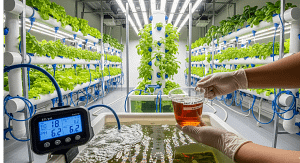
We translate complex plant physiology into simple steps for diagnosing issues, balancing nutrients, and preventing pests. Our proven methods deliver healthier plants and bigger harvests – tailored for home and commercial growers alike.
Learn the essentials of plant care with tips that keep your crops thriving. From nutrition to maintenance, we guide you toward healthier, stronger, and more productive plants.
Craft custom feeding schedules that prevent deficiencies and boost yields. Our guides compare organic vs. synthetic nutrients, NPK ratios, and pH stabilization hacks.
Build pest-resistant ecosystems using organic IPM strategies. Learn prevention, identification, and non-toxic treatments for common issues.
Catch plant stress early using sensors and checklists. Compare top monitoring tools, from budget pens to automated Wi-Fi systems.
Sign up for my newsletter to see new photos, tips, and blog posts.
Plant care doesn’t stop after you’ve chosen your system—it’s an ongoing process. From balancing nutrients to spotting early signs of stress, our Plant Care FAQ helps you handle the daily challenges that come with hydroponic or aeroponic gardening.
In this section, you’ll learn how to prevent common mistakes like nutrient burn, handle pH fluctuations, and fine-tune your lighting schedule for maximum growth. We don’t just give you generic advice—we break things down so you know exactly what’s happening with your plants and how to respond.
Think of it as a troubleshooting buddy you can check anytime your plants start acting up. Whether you’re growing leafy greens that suddenly stall or cannabis that shows weird leaf colors, you’ll find the answers here.
pH sounds like chemistry class all over again, right? Don’t worry—it’s way simpler than it sounds. Basically, pH tells you if your nutrient water is acidic or alkaline on a scale of 0 to 14.
Here’s the kicker: if your pH is off, your plants can literally starve even when the food’s right there. It’s called nutrient lockout. Imagine sitting at a table full of food but your mouth is taped shut—that’s your plant with bad pH.
Most crops like it slightly acidic, around 5.5–6.5. Keep it in that sweet spot, and the roots unlock nutrients like a key fitting a lock. Ignore it, and you’ll chase problems all season.
Pro tip: don’t just guess—get a meter and check regularly. Saved me more than once.
The best tool isn’t a spray or gadget—it’s your eyes. I make it part of my morning routine: coffee in one hand, quick garden check with the other.
Look for yellowing leaves, brown spots, or weird patterns—that usually means a fungus or disease is knocking. Tiny holes or chewed edges? That’s bugs. Flip the leaves over and check the undersides. Aphids, spider mites, mealybugs—they love hiding there.
I keep a cheap magnifying glass nearby because some of those pests are practically invisible until the damage is done. Catch one bug on a leaf today, and you save yourself from a full-on invasion tomorrow.
Easiest answer? Don’t let them in at all.
Here’s my routine: any new plant gets quarantined for a couple of weeks. Yeah, it feels paranoid, but it works. After that, cleanliness is your friend. Dead leaves, fallen debris—that’s like free real estate for pests. Keep it tidy.
And finally, a little prevention spray goes a long way. Neem oil or insecticidal soap used regularly makes it a lot harder for bugs to settle in. Think of it as locking the doors before trouble even shows up.
Absolutely. Think of it like feeding a kid versus feeding a bodybuilder. Different needs at different times.
When your plants are young and leafy, they crave nitrogen. It’s what powers that lush, green growth. Once they shift into flowering and fruiting mode, the cravings change—phosphorus and potassium become the stars of the show.
Feed them the wrong mix at the wrong stage and you’ll see it—weak plants, poor yields, and frustration all around. Dial in the timing, though, and you’ll watch your plants explode with growth and produce like crazy.
This one trips up almost everyone. I still second-guess myself sometimes.
Here’s what I’ve learned: overwatered plants turn yellow, feel droopy, and sometimes even smell bad (that’s root rot creeping in). Underwatered plants also wilt, but they’ll feel dry and crispy instead of soft.
Pro tip: forget the “water every X days” advice. Stick your finger in the medium. If it’s dry a couple of inches down, water. If it’s damp, leave it. Plants don’t follow calendars—they follow conditions.